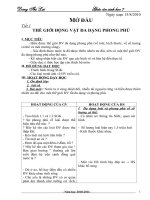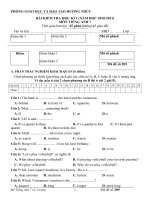Bài giảng Chapter 7 The Quantum-Mechanical Model of the Atom
Bạn đang xem bản rút gọn của tài liệu. Xem và tải ngay bản đầy đủ của tài liệu tại đây (4.76 MB, 79 trang )
Chemistry, Julia Burdge, 2st Ed.
McGraw Hill.
Chapter 7
The QuantumMechanical
Model of the
Atom
Mr. Truong Minh Chien ;
/>
2011, NKMB Co., Ltd.
The Behavior of the Very Small
• electrons are incredibly small
a single speck of dust has more electrons than the
number of people who have ever lived on earth
• electron behavior determines much of the
behavior of atoms
• directly observing electrons in the atom is
impossible, the electron is so small that
observing it changes its behavior
Tro, Chemistry: A Molecular Approach
2
A Theory that Explains Electron Behavior
• the quantum-mechanical model explains the manner
•
electrons exist and behave in atoms
helps us understand and predict the properties of atoms
that are directly related to the behavior of the electrons
why some elements are metals while others are nonmetals
why some elements gain 1 electron when forming an anion,
while others gain 2
why some elements are very reactive while others are
practically inert
and other Periodic patterns we see in the properties of the
elements
Tro, Chemistry: A Molecular Approach
3
The Nature of Light
its Wave Nature
• light is a form of electromagnetic radiation
composed of perpendicular oscillating waves, one for the
electric field and one for the magnetic field
an electric field is a region where an electrically charged particle
experiences a force
a magnetic field is a region where an magnetized particle experiences
a force
• all electromagnetic waves move through space at the
same, constant speed
3.00 x 108 m/s in a vacuum = the speed of light, c
Tro, Chemistry: A Molecular Approach
4
Speed of Energy Transmission
Chemistry, Julia Burdge, 2nd e., McGraw Hill.
5
Electromagnetic Radiation
Chemistry, Julia Burdge, 2nd e., McGraw Hill.
6
Characterizing Waves
• the amplitude is the height of the wave
the distance from node to crest
or node to trough
the amplitude is a measure of how intense the light
is – the larger the amplitude, the brighter the light
• the wavelength, () is a measure of the distance
covered by the wave
the distance from one crest to the next
or the distance from one trough to the next, or the
distance between alternate nodes
Tro, Chemistry: A Molecular Approach
7
Wave Characteristics
Chemistry, Julia Burdge, 2nd e., McGraw Hill.
8
Wave animation
Tro, Chemistry: A Molecular Approach
9
Characterizing Waves
• the frequency, () is the number of waves that
pass a point in a given period of time
the number of waves = number of cycles
units are hertz, (Hz) or cycles/s = s-1
1 Hz = 1 s-1
• the total energy is proportional to the amplitude
and frequency of the waves
the larger the wave amplitude, the more force it has
the more frequently the waves strike, the more total
force there is
Tro, Chemistry: A Molecular Approach
10
The Relationship Between
Wavelength and Frequency
• for waves traveling at the same speed, the shorter
the wavelength, the more frequently they pass
• this means that the wavelength and frequency of
electromagnetic waves are inversely proportional
since the speed of light is constant, if we know
wavelength we can find the frequency, and visa versa
s
m
-1
Tro, Chemistry: A Molecular Approach
c
m
s
11
Example 7.1- Calculate the wavelength of red
light with a frequency of 4.62 x 10 14 s-1
Given: = 4.62 x 1014 s-1
Find: , (nm)
Concept Plan: s-1)
(m)
c
1 nm
(nm)
10 9 m
Relationships: ∙ = c, 1 nm = 10-9 m
Solve:
c 3.00 108 m s -1
7
6
.
49
10
m
14
1
4.62 10 s
1 nm
7
6.49 10 m 9 6.49 102 nm
10 m
Check: the unit is correct, the wavelength is appropriate
for red light
Chemistry, Julia Burdge, 2nd e., McGraw Hill.
12
Practice – Calculate the wavelength of a radio
signal with a frequency of 100.7 MHz
Tro, Chemistry: A Molecular Approach
13
Practice – Calculate the wavelength of a radio
signal with a frequency of 100.7 MHz
Given: = 100.7 MHz
Find: , (m)
Concept Plan: Hz)
6 -1
10 s
1 MHz
(s-1)
c
(m)
Relationships: ∙ = c, 1 MHz = 106 s-1
Solve:
106 s -1
100.7 MHz
1.007 108 s -1
1 MHz
c 3.00 108 m s -1
2.98 m
8
1
1.007 10 s
Check: the unit is correct, the wavelength is appropriate
for radiowaves
Chemistry, Julia Burdge, 2nd e., McGraw Hill.
14
Color
• the color of light is determined by its wavelength
or frequency
• white light is a mixture of all the colors of visible light
a spectrum
RedOrangeYellowGreenBlueViolet
• when an object absorbs some of the wavelengths of
white light while reflecting others, it appears colored
the observed color is predominantly the colors reflected
Chemistry, Julia Burdge, 2nd e., McGraw Hill.
15
Amplitude & Wavelength
16
Electromagnetic Spectrum
Tro, Chemistry: A Molecular Approach
17
Continuous Spectrum
Tro, Chemistry: A Molecular Approach
18
The Electromagnetic Spectrum
• visible light comprises only a small fraction of
all the wavelengths of light – called the
electromagnetic spectrum
• short wavelength (high frequency) light has
high energy
radiowave light has the lowest energy
gamma ray light has the highest energy
• high energy electromagnetic radiation can
potentially damage biological molecules
ionizing radiation
Tro, Chemistry: A Molecular Approach
19
Thermal Imaging using Infrared Light
Tro, Chemistry: A Molecular Approach
20









